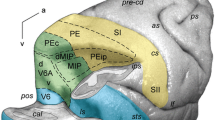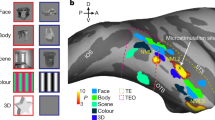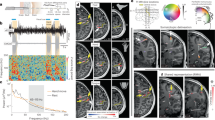Summary
Two series of experiments are reported in this paper. The first concerns the movement representation in the macaque inferior area 6, the second the functional properties of neurons located in the caudal part of this area (histochemical area F4). By combining single neuron recording and intracortical microstimulation, we found that inferior area 6 is somatotopically organized. The axio-proximal movements are represented caudally, the distal movements are represented near the arcuate sulcus. The mouth field is located laterally, the hand field medially. There is no leg field. A comparison between neuron properties and histochemical characteristics of inferior area 6 showed that the proximal movements representation includes most of area F4, whereas the distal movements representation corresponds to area F5 and to the rostral part of F4. Neurons located in that part of F4 where proximal movements are represented respond very well to tactile stimuli. They have large receptive fields mostly located on the face and on the upper part of the body. A large number of these neurons respond to visual stimuli. Objects approaching the animal are particularly effective. The tactile and the visual receptive fields are in register. The most represented movements are reaching movements, movements bringing the hand to the mouth or to the body and facial movements. There is a congruence between location of visual fields and preferred arm movements. It is argued that the receptive field arrangement and the response properties are more complex in area F4 than in the primary motor cortex and that area F4 neurons are involved in the control of arm movements towards different space sectors.
Similar content being viewed by others
References
Alstermark B, Lundberg A, Norrsell U, Sybirska E (1981) Integration in descending motor pathways controlling the forelimb in the cat. 9. Differential behavioural defects after spinal cord lesions interrupting defined pathways from higher centres to motoneurones. Exp Brain Res 42: 299–318
Barbas H, Pandya DN (1987) Architecture and frontal cortical connections of the premotor cortex (area 6) in the Rhesus monkey. J Comp Neurol 256: 211–228
Fulton JF (1934) Forced grasping and grasping in relation to the syndrome of the premotor area. Arch Neurol Psychiat 31: 221–235
Gentilucci M, Scandolara C, Pigarev IN, Rizzolatti G (1983) Visual responses in the postarcuate cortex (area 6) of the monkey that are independent of eye position. Exp Brain Res 50: 464–468
Godschalk M, Lemon RN, Nijs HGT, Kuypers HGJM (1981) Behaviour of neurons in monkey peri-arcuate and precentral cortex before and during visually guided arm and hand movements. Exp Brain Res 44: 113–116
Godschalk M, Lemon RN, Kuypers HGJM, Ronday HK (1984) Cortical afferents and efferents of monkey postarcuate area: an anatomical and electrophysiological study. Exp Brain Res 56: 410–424
Halsband U, Passingham R (1982) The role of premotor and parietal cortex in the direction of action. Brain Res 240: 368–372
Humphrey DR (1979) On the cortical control of visually directed reaching: contributions by nonprecentral motor areas. In: Talbot RE, Humphrey DR (eds) Posture and movement. Raven Press, New York, pp 51–112
Hyvärinen J (1982) The parietal cortex of monkey and man. Studies of brain function, Vol 8. Springer, Berlin Heidelberg New York, 202 p
Illert M, Lundberg A, Tanaka R (1976) Integration in descending motor pathways controlling the forelimb in the cat. 1. Pyramidal effects on motoneurons. Exp Brain Res 26: 509–519
Illert M, Lundberg A, Tanaka R (1977) Integration in descending motor pathways controlling the forelimb in the cat. 3. Convergence on propriospinal neurones transmitting disynaptic excitation from the corticospinal tract and other descending tracts. Exp Brain Res 29: 323–346
Künzle H (1978) An autoradiographic analysis of the efferent connections from premotor and adjacent prefrental regions (area 6 and 9) in Macaca fascicularis. Brain Behav Evol 15: 185–234
Kurata K, Tanji J (1986) Premotor cortex neurons in macaques: activity before distal and proximal forelimb movements. J Neurosci 6: 403–411
Kwan HC, MacKay WA, Murphy JT, Wong YC (1978) Spatial organization of precentral cortex in awake primates. II. Motor outputs. J Neurophysiol 41: 1120–1131
Lemon RN, Porter R (1976) Afferent input to movement-related precentral neurones in conscious monkeys. Proc R Soc Lond [Biol] 194: 313–339
Lemon RN, Hanby JA, Porter R (1976) Relationship between the activity of precentral neurones during active and passive movements in conscious monkeys. Proc R Soc Lond [Biol] 194: 341–373
Lynch JC (1980) The functional organization of posterior parietal association cortex. Behav Brain Sci 3: 485–534
Martino AM, Strick PL (1987) Corticospinal projections originate from the arcuate premotor area. Brain Res 404: 307–312
Matelli M, Luppino G, Rizzolatti G (1985) Patterns of cytochrome oxidase activity in the frontal agranular cortex of the macaque monkey. Behav Brain Res 18: 125–137
Matelli M, Camarda R, Glickstein M, Rizzolatti G (1986) Afferent and efferent projections of the inferior area 6 in the macaque monkey. J Comp Neurol 251: 281–298
Matsumura M, Kubota K (1979) Cortical projection of hand-arm motor area from postarcuate area in macaque monkey: a histological study of retrograde transport of horseradish peroxidase. Neurosci Lett 11: 241–246
Moll L, Kuypers HGJM (1977) Premotor cortical ablation in monkeys: contralateral changes in visually guided reaching behavior. Science 198: 317–319
Mountcastle VB, Lynch JC, Georgopoulos A, Sakata H, Acuna C (1975) Posterior parietal association cortex of the monkey: command functions for operations within extrapersonal space. J Neurophysiol 38: 871–908
Muakkassa KF, Strick PL (1979) Frontal lobe inputs to primate motor cortex: evidence for four somatotopically organized “premotor” areas. Brain Res 177: 176–182
Murray EA, Coulter GD (1981) Organization of cortico-spinal neurons in the monkey. J Comp Neurol 195: 339–365
Penfield W, Welch K (1951) Supplementary motor area of the cerebral cortex. Arch Neurol Psychiat 66: 289–317
Petrides M (1982) Motor conditional associative-learning after selective prefrontal lesions in the monkey. Behav Brain Res 5: 407–413
Phillips GC, Porter R (1977) Corticospinal neurones. Their role in movement. Academic Press, London, 450 p
Pigarev IN, Rodionova EI (1986) Neurons with visual receptive fields independent of eye position in the caudal part of the ventral bank of cat cruciate sulcus. Neurophysiology (Kiev) 18: 800–804
Rizzolatti G, Scandolara C, Gentilucci M, Camarda R (1981a) Response properties and behavioral modulation of “mouth” neurons of the postarcuate cortex (area 6) in macaque monkeys. Brain Res 255: 421–424
Rizzolatti G, Scandolara C, Matelli M, Gentilucci M (1981b) Afferent properties of periarcuate neurons in macaque monkeys. I. Somato-sensory responses. Behav Brain Res 2: 125–146
Rizzolatti G, Scandolara C, Matelli M, Gentilucci M (1981c) Afferent properties of periarcuate neurons in macaque monkeys. II. Visual responses. Behav Brain Res 2: 147–163
Rizzolatti G, Camarda R, Fogassi L, Gentilucci M, Luppino G, Matelli M (1988) Functional organization of inferior area 6 in the macaque monkey. II. Area F5 and the control of distal movements. Exp Brain Res 71: 491–507
Sessle BJ, Wiesendanger M (1982) Structural and functional definition of the motor cortex in the monkey (Macaca fascicularis). J Physiol (Lond) 323: 245–265
Strick PL (1985) How do the basal ganglia and cerebellum gain access to the cortical motor areas? Behav Brain Res 18: 107–123
Toyoshima K, Sakai H (1982) Exact cortical extent of the origin of the corticospinal tract (CST) and the quantitative contribution to the CST in different cytoarchitectonic areas. A study with horseradish peroxidase in the monkey. J Hirnforsch 23: 257–269
Wannier TMJ, Tollte M, Hepp-Reymond MC (1986) On the problem of multiple hand representation in area 4 of the alert Macaca fascicularis. Experientia 42: 711
Weinrich M, Wise SP (1982) The premotor cortex of the monkey. J Neurosci 2: 1329–1345
Weinrich M, Wise SP, Mauritz KH (1984) A neurophysiological study of the premotor cortex in the Rhesus monkey. Brain 107: 385–414
Wise SP (1985) The primate premotor cortex: past, present and preparatory. Annu Rev Neurosci 8: 1–19
Wong YC, Kwan HC, MacKay WA, Murphy JT (1978) Spatial organization of precentral cortex in awake primates. I. Somatosensory inputs. J Neurophysiol 41: 1107–1119
Woolsey CN, Settlage PH, Meyer DR, Sencer W, Pinto Hamuy T, Travis AM (1952) Patterns of localization in precentral and “supplementary” motor areas and their relation to the concept of a premotor area. Res Publ Assoc Nerv Ment Dis 30: 238–264
Author information
Authors and Affiliations
Rights and permissions
About this article
Cite this article
Gentilucci, M., Fogassi, L., Luppino, G. et al. Functional organization of inferior area 6 in the macaque monkey. Exp Brain Res 71, 475–490 (1988). https://doi.org/10.1007/BF00248741
Received:
Accepted:
Issue Date:
DOI: https://doi.org/10.1007/BF00248741




